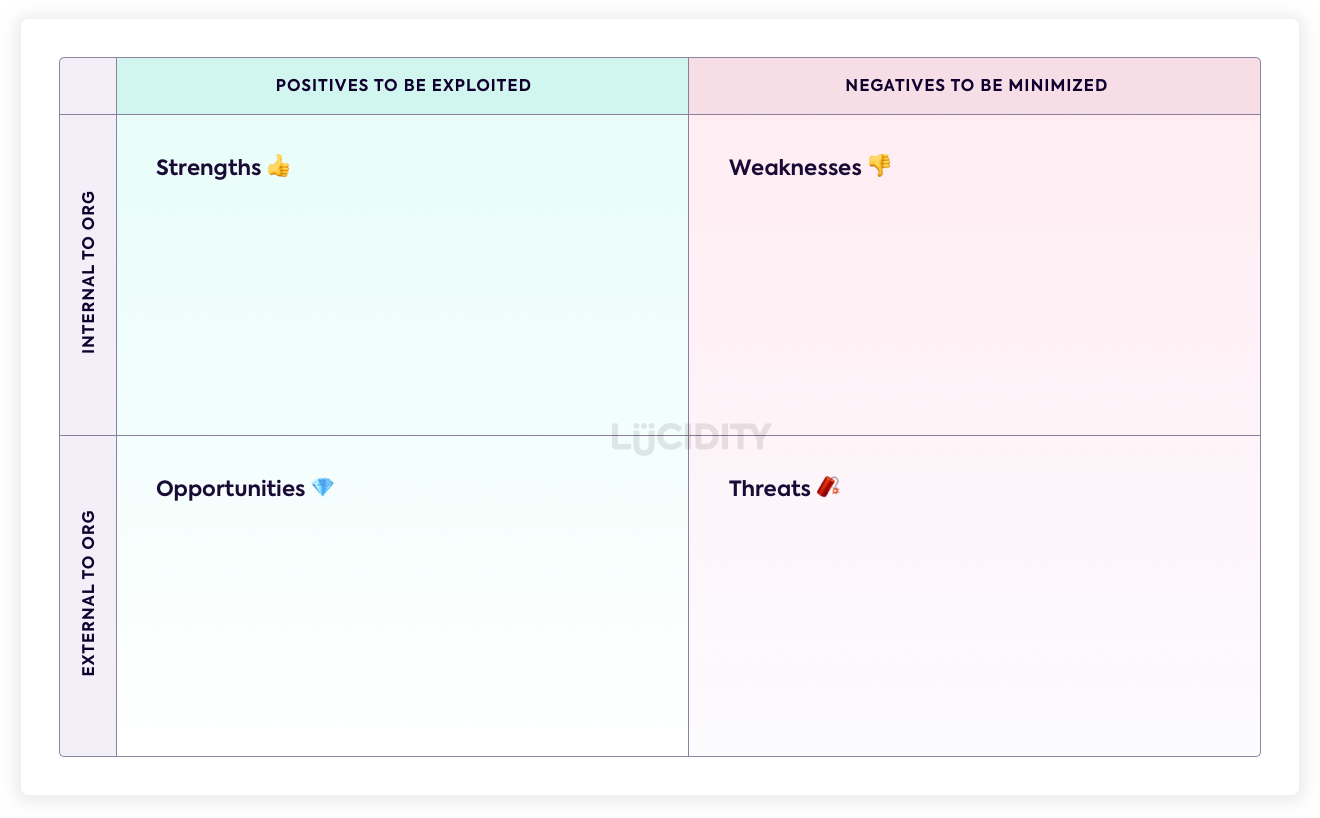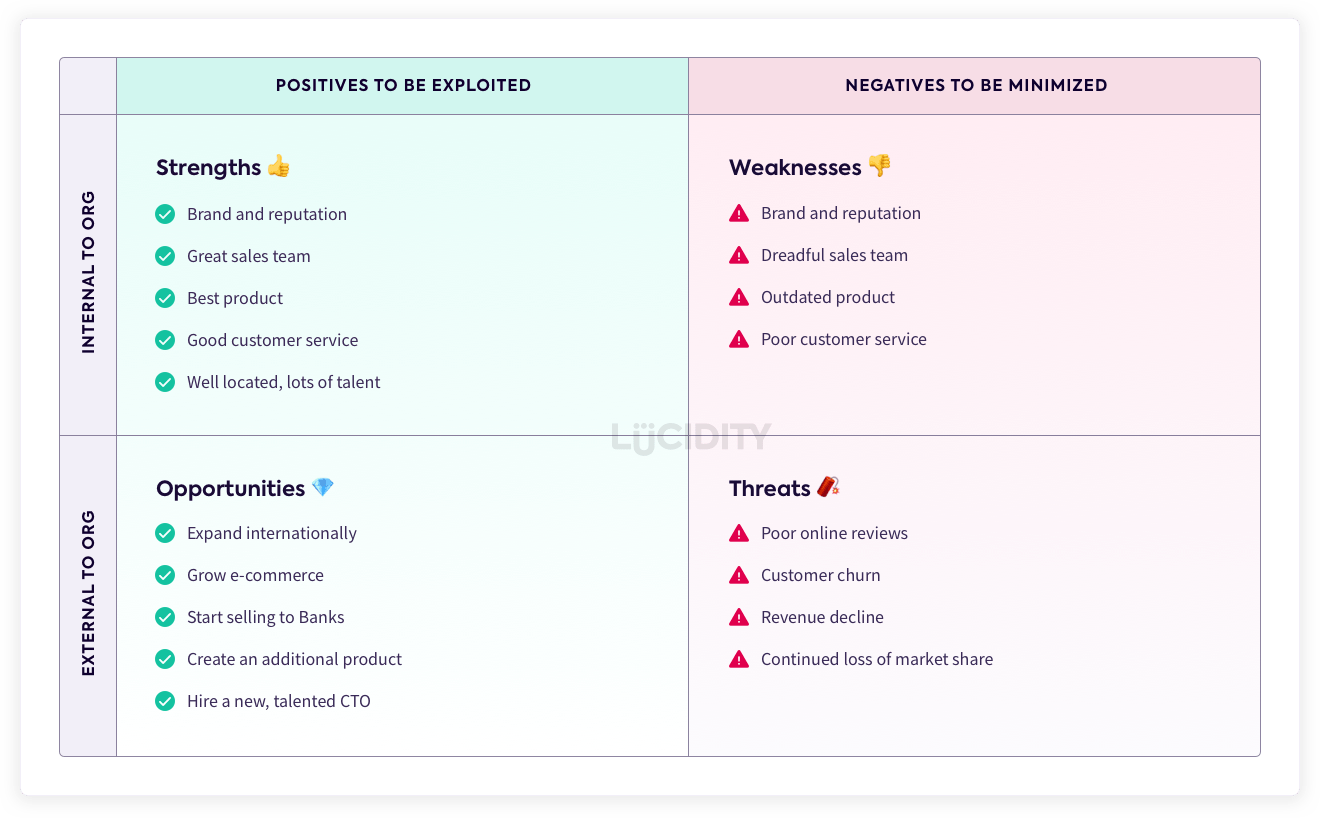What is a SWOT Analysis?
A SWOT Analysis is a framework for identifying Strengths, Weaknesses, Opportunities and Threats. It is often presented a 2×2 matrix and can be applied to any business and industry, from non-profit charities through to large corporate entities.
The structure of the grid means the top row looks at all internal issues, both positive and negative, while the bottom evaluates the external factors. Similarly, the left of the grid is positive, while the right of the grid is negative.
A well thought out SWOT will provide you with new opportunities to go for as well as ensuring threats to your business are mitigated or eliminated.
When should you do a SWOT?
It’s best practise to perform a SWOT whenever you are going to make key strategic decisions or if you are reviewing your overall strategy. A SWOT can be a useful tool for companies to evaluate their own position or the position of individual departments, products, or services.
What are the advantages of SWOT?
SWOT as a framework has several advantages:
- It’s simple to understand and use
- There’s an easy process to follow through (see below)
- You can do it on your own, as a team in person, or as a group remotely
- It can provide a good analysis of both internal and external issues
What are some of the limitations of SWOT?
While it’s a great tool, SWOT can be mishandled:
- SWOT itself is not an analysis, but a framework for capturing analysis conclusions
- It has no actions within the framework
- It is easy to be too broad or not factual enough, which will disrupt the SWOT
- It doesn’t contain a way to weight the importance of the elements of the SWOT
How do you make the most out of SWOT?
It’s likely you’ll have heard of SWOT before, it’s one of the few strategic frameworks to enter the lexicon for most people in business. If done well, a SWOT can be one of the most powerful and revealing frameworks.
There are three golden rules to follow before you begin your SWOT:
- Prepare for the session by getting feedback from clients
- Talk to your employees and get their thoughts on the business
- Always be honest in the SWOT – these are internal tools to help you
What preparation should be done before a SWOT?
While no preparation is required for a SWOT, it is helpful to have knowledge of:
- Current client relationships
- Example good case studies of sales and service
- Example bad case studies of sales and service
- Latest news in your sector
- Any competitive activity your aware of
- Employee feedback
If in a group, these can be shared via an email beforehand or presented on the day.
What’s the best medium for running a SWOT session?
SWOT works best when put together by a cross-disciplined team either physically or virtually. You need a mix of employees with different experiences and market knowledge to ensure you capture all aspects of the business.
What are the risks of completing a SWOT?
The main risk when completing a SWOT is biased or subjective classification of strengths, weaknesses, opportunities and threats. It’s therefore rally important to ensure you have input into your SWOT from different people within a company.
A SWOT will also only provide a list, there’s no concept of prioritisation or the risk/reward of each opportunity. It’s important that further evaluation is done on your opportunities and actions, using either a TOWS or the SFA Matrix.
What is an example SWOT?
Many example SWOTs can be found in Lucidity such as:
How often is SWOT updated?
It is best practise to review your SWOT on a quarterly basis, this helps provide you with context on if you’re succeeding towards maximising your opportunities and minimising your threats, while also taking into account of your changing landscape.
What is the difference between TOWS and SWOT?
The big difference between a TOWS and a SWOT is the latter explores the relationships between the different parts of a SWOT, examining how they link up and complement each other. You can find out more by reading our introduction to TOWS Analysis.
What other tools work well with SWOT?
You should look to develop a PESTLE Analysis or Five Forces Analysis, both of which focus outside your organisation, alongside your SWOT. This will inform and develop your thinking, leading to an improved SWOT Analysis.
What is the best way to communicate a SWOT?
Many companies communicate their SWOT in full, ensuring the teams are aware of the different internal and external factors that impact thee business. A good SWOT will have been composed with input from across the business.
Alternatively, for a positive spin on SWOT, look at the SOAR framework. It takes the Strengths and Opportunities of SWOT and includes the Aspirations and desired Results for a business, often resulting in a more positive communication message for the wider company.
Can a SWOT be used on an individual?
Yes – the SWOT framework is sometimes used to map out an individual or personal list of strengths, weaknesses, opportunities and threats. It’s not designed for that use but can be effective depending on the person. It’s worth also looking at Locke’s Goal Setting Theory for more on individual goal setting.
Who invented SWOT?
SWOT is commonly credited to a researcher called Albert Humphrey from SRI, an independent research centre in the 1960s/1970s.
Where can I find a guide to completing my SWOT?
Ready to create your own SWOT? You can find it in our strategy software today and check out Ultimate Guide to SWOT Analysis, or watch our video guide to SWOT.
Where can I find out more information on SWOT?
You can check out the Ultimate Guide to SWOT Analysis to find everything you’d ever need about SWOT, including tips, examples, how-tos and more!
















